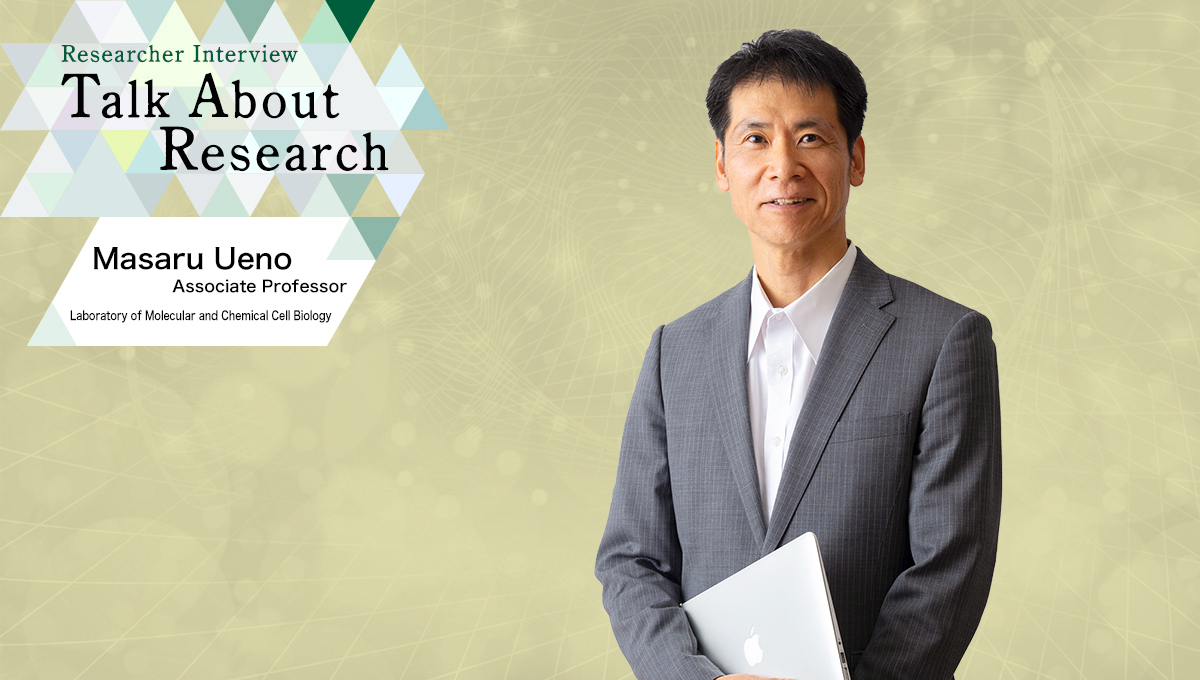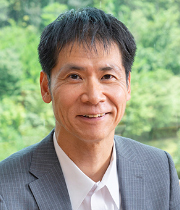Made the world’s first findings in research
on telomeric functions using fission yeast
Dr. Ueno’s research subject is chromosomes. Chromosomes have not been clarified in many respects even until now.
- Why doesn’t DNA with a length of 2 m become tangled despite that it is contained in a cell nucleus with a size of 6 µm?
- What is the mechanism that activates particular genes in each cell out of about 20,000 genes?
- The frequency of DNA replication errors is 6 errors per 6 billion base pairs. Why is it so accurate?
- What is the mechanism that evenly partitions 92 chromosomes into two groups of 46 chromosomes?
- How do cells recognize damage to DNA and repair it?
Obsessed with this mysteriousness of chromosomes, Dr. Ueno tries to clarify these questions from a variety of angles.
Dr. Ueno places a particular focus on telomeres. Telomeres are large complexes of repeated DNA sequences (telomeric DNA) and protein that exist at the ends of chromosomes. Telomeres become shorter every time the cell divides. Once telomere length reaches a critical limit, the cell stops dividing and consequently becomes senescent. However, it is known that if the cell continues dividing, the ends of chromosomes are damaged, and the cell becomes cancerous to maintain the ends of chromosomes. Since the length of telomeric DNA has a close relationship with aging and cancer as seen from the above, findings from research on telomeres could be applied to the control of aging and cancer.
”The primary cause of cancer is chromosomal abnormalities. Compared with normal cells, cancer cells exhibit significant chromosomal instabilities, such as an abnormal number of chromosomes, attachment between chromosomes, and partial loss of chromosomes. Keeping chromosomes stable leads to the prevention of cancer,” Dr. Ueno says.

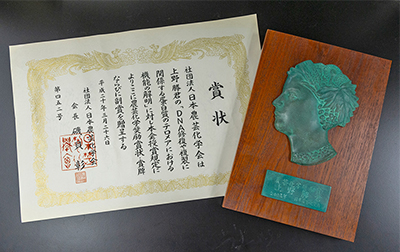
With respect to aging, he also pays special attention to the functions of the nucleolus and the
nuclear envelope contained in the cell nucleus.
“It is known that the cells of progeria patients often exhibit significant abnormalities in the
shape of the nuclear envelope or an abnormally high nucleolar growth rate. These facts indicate that
the nuclear envelope and the nucleolus have a close relationship with human health, but it has not
been clarified at all as to what role they play in the functions of chromosomes,” Dr. Ueno says
Dr. Ueno began his research on telomeres in 1997. At that time, double-stranded telomeric DNA-binding protein Taz1 (an orthologue of human TRF1 and TRF2) was the only telomere-associated protein in fission yeast that had been reported. Therefore, he focused on finding novel fission yeast proteins that have telomeric functions and analyzing their functions. Particularly, he analyzed for the first time in the world whether nuclease Mre11 and helicase Dna2, which are associated with the replication, recombination and repair of DNA, and non-sequence-specific single-stranded DNA-binding protein RPA have telomeric functions or not.
As a result, the following findings were made:
- In taz1 disruptant cells, single-stranded telomere overhangs*are generated in a Mre11-dependent manner.
- Dna2, a protein required for DNA replication, is required for the generation of single-stranded overhangs at telomere ends.
- Double mutant cells lacking DNA replication factors rpa and taz1 rapidly lose their telomeric DNA. However, the loss of telomeric DNA is suppressed by the excessive expression of Pot1.
These findings were published in world’s leading magazines in this field, the Journal of Molecular Cell Biology, Volume 2 and Molecular Biology of the Cell, Volume 1, and highly acclaimed. Dr. Ueno had the honor of receiving the FY2008 Japan Society for Bioscience, Biotechnology, and Agrochemistry (JSBBA) Award for Young Scientists for his achievements.
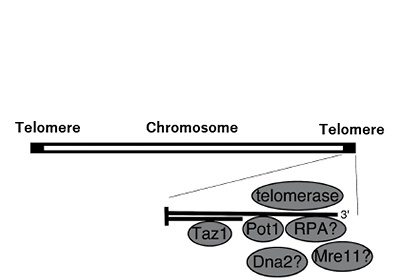 Fig. 1 Telomeres and Telomere Binding Proteins in Fission Yeast
Fig. 1 Telomeres and Telomere Binding Proteins in Fission YeastChromosome ends in fission yeast have an approximately 300 bp repeat sequence, (GGTTACA)n, called telomeric DNA. Taz1 binds specifically to double-stranded telomeric DNA, and Pot1 binds specifically to single-stranded telomeric DNA. RPA is a single-stranded non-specific DNA-binding protein, Mre11 is a nuclease associated with DNA repair, and Dna2 is a helicase associated with DNA repair. It was not known whether these proteins have telomeric functions or not. Telomerase is an RNA-protein complex that includes an enzyme that extends telomeric DNA.
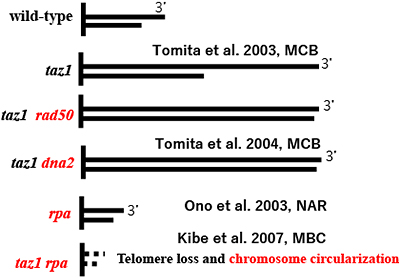 Fig. 2 Telomeric phenotypes of DNA repair and replication factors at fission yeast
telomeres revealed by the group of Dr. Ueno. Only the telomeric DNA sections at the ends of
chromosomes are shown by straight lines.
Fig. 2 Telomeric phenotypes of DNA repair and replication factors at fission yeast
telomeres revealed by the group of Dr. Ueno. Only the telomeric DNA sections at the ends of
chromosomes are shown by straight lines.* Single-stranded overhang: Telomeric DNA consists of a double-stranded part and a single-stranded part at the ends. The single-stranded part has an overhang at the 3’ end of DNA. The 3’ end is the end that terminates at the hydroxyl (OH) group attached to the third carbon in the deoxyribose.
A series of new findings on ring chromosomes
associated with cancer and genetic diseases
New findings followed even after that. In the process of its research on chromosomes, Dr. Ueno’s research team found that the inactivation of a particular gene causes the shortening of telomeres, which subsequently causes both ends of chromosomes to fuse with each other, resulting in the formation of so-called “ring chromosomes.” Although the expression of ring chromosomes itself had been found by that time, his team identified the gene associated with the expression for the first time in the world.
In the wake of this finding, Dr. Ueno additionally began research on ring chromosomes.
“Ring chromosomes are found even in human cells. In particular, it has been found that ring
chromosomes are found in about 70% of cells of dermatofibrosarcoma protuberans or other similar
types of cancers and 85% of cells of well-differentiated liposarcoma. Then, thinking that it may be
possible to kill cancer cells if we can kill only cells with ring chromosomes, I began detailed
research on the characteristics of ring chromosomes,” Dr. Ueno says.
After that, Dr. Ueno’s research team began exploring the weak points of yeast cells with ring chromosomes by using yeast cells that have been manipulated to have ring chromosomes. In the process of this research, the team found that a protein called “chromosomal passenger complex” is required to maintain ring chromosomes. This finding was published as a press release of Hiroshima University in January 2018 as well as on the online issue of PLOS ONE, an American science magazine. Currently, there is no other researcher in the world who conducts research on ring chromosomes as deeply as Dr. Ueno does.
Dr. Ueno’s research is ongoing for further development. With the aim of applying findings from his research on chromosomes to cancer treatment, his research team currently is exploring the weak points of yeast cells that have been provided with cancerous characteristics by genetic modification in an attempt to find unknown weak points of cancer cells.
This research is conducted in the framework of “The Research Center for the Mathematics on Chromatin Live Dynamics” established at Hiroshima University under a project adopted by the Ministry of Education, Culture, Sports, Science and Technology in 2012, and Dr. Ueno is a member of this research center. Since a variety of interdisciplinary research projects are ongoing, their progress is highly anticipated.
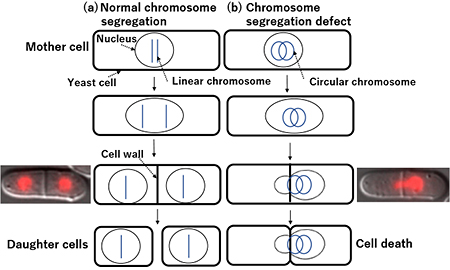
(b) A yeast cell with ring chromosomes (i.e. a yeast cell provided with characteristics similar to cancer cells), under the condition that the function of chromosomal passenger complex is a little low, does not distribute ring chromosomes properly, leading to the formation of a cell wall with chromosomes distributed unevenly. Consequently, the cell cannot divide properly, resulting in cell death. The microscopic photograph at the left end of the figure shows yeast cells to which linear chromosomes were properly distributed even under the condition that the function of chromosomal passenger complex is a little low. The microscopic photograph at the right end of the figure shows yeast cells to which ring chromosomes were not properly distributed due to the condition that the function of chromosomal passenger complex is a little low. The cell nuclei were visualized by fusing a red fluorescent protein to a protein in the nuclei.
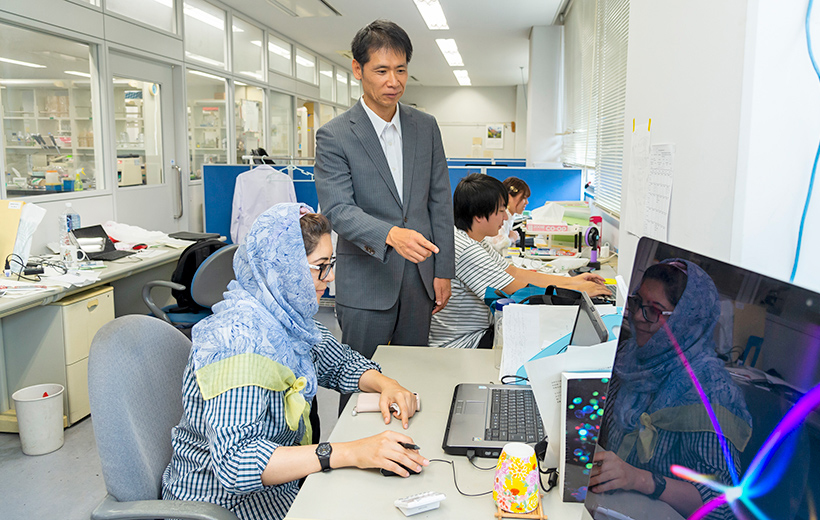
Besides verification of findings with fission yeast by using human cells,
actively involved in
publicity of information about the relationship
between chromosomes and lifestyle habits
One of the characteristics of Dr. Ueno’s approach to research on chromosomes is that he first conducts research using fission yeast, an organism that consists of a single cell similar to human cells, and subsequently verifies the findings obtained thereby by using human cells. “This method allows us to make new findings in a short period of time and also allows master’s students to quickly learn experimental skills even if they start an experiment from scratch. They can possibly obtain a sufficient number of findings to write a thesis within two years,” Dr. Ueno says.
Another characteristic of his approach is that, in basic research on chromosomes, as described earlier, he adopts mathematical methods to make detailed analysis of the motion and positions of molecules in chromosomes and cell nuclei with assistance from experts of the mathematical molecular biology program. “By using leading-edge equipment such as the “spinning disc fluorescent microscope” and applying mathematical analysis, we are about to discover life phenomena that biologists have not been able to find by now,” Dr. Ueno says.
According to Dr. Ueno, he has two motivation sources. One is an intellectual curiosity about the basic principles of life, and the other is a desire to contribute to cancer treatment. He says that each of them has the same degree of importance for him. What plans does he have for his research in the future?
“I want to find unknown life phenomena by quantitatively analyzing the motion and spatial arrangement of chromosomes, as well as the weak points of cancer by using yeast cells provided with the characteristics of cancer cells. And I also want to discover new medicinal substances for chromosome-targeted drugs and clarify their working mechanisms,” Dr. Ueno says.
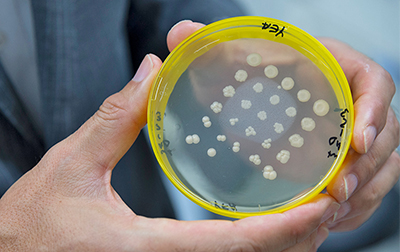

He also continued as follows: “Research on chromosomes makes me recognize how important our lifestyle habits are. For example, mental stress, smoking and excessive drinking damage telomeres and chromosomes. Conversely, moderate exercise is effective in protecting telomeres and preventing cancer. So, I want to communicate information about the relationship between our lifestyle habits and chromosomes as well as telomeres to society in an easy-to-understand manner.”
Even now, he is actively involved in publicity activities to communicate this kind of information, such as public seminars. However, he emphasizes: “It is often difficult to change our lifestyle habits even though we know that we need to do it. So, I will repeatedly communicate information to raise public awareness of the importance of lifestyle habits.”
And he added as follows: “It will be more exciting if our findings with fission yeast are true with human cells. That is what we are investigating now.”
It may not be long before a long-awaited breakthrough for human beings will be announced.
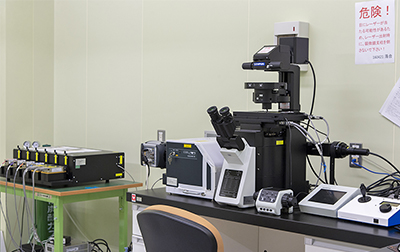 Spinning disc fluorescent microscope
Spinning disc fluorescent microscope
 Clarification of chromosomal control mechanisms by quantitative analysis of chromatin
dynamics
Clarification of chromosomal control mechanisms by quantitative analysis of chromatin
dynamics
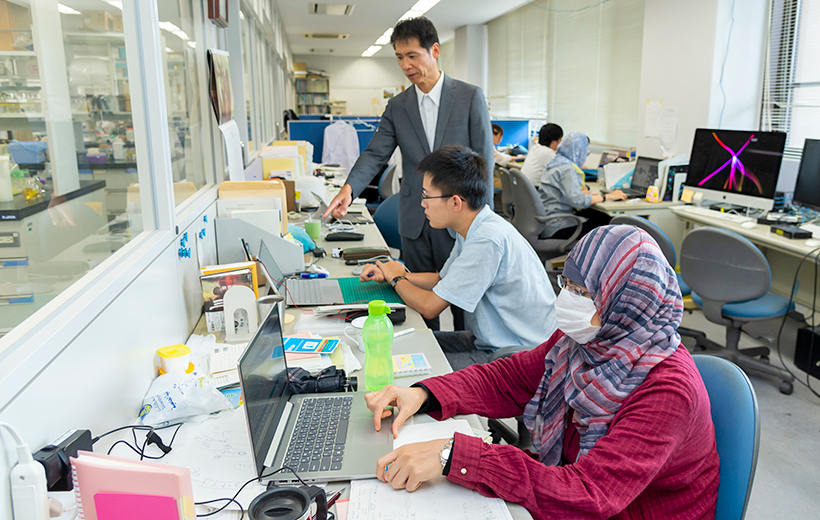 Opened on March 25, 2020
Opened on March 25, 2020

